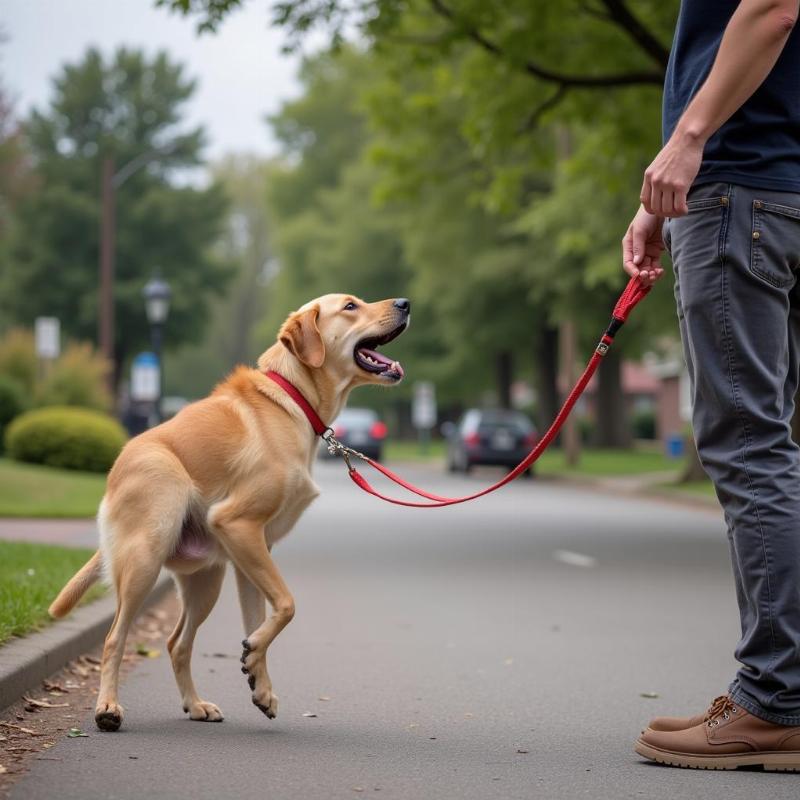Walking your dog should be a pleasurable experience, not a stressful battle against barking, lunging, and pulling. If your dog displays these reactive behaviors on walks, you’re not alone. Many dog owners face this challenge, but with patience, understanding, and the right training techniques, you can transform your walks into enjoyable outings for both you and your furry friend. This guide provides a comprehensive approach to training a reactive dog, focusing on methods that build confidence and reduce anxiety.
Understanding Reactivity in Dogs
Before diving into training, it’s crucial to understand what triggers your dog’s reactivity. Is it other dogs, people, cars, or specific sounds? Identifying the triggers is the first step in developing a tailored training plan. Reactivity often stems from fear, frustration, or overexcitement, and it manifests as barking, lunging, growling, or even whining.
 Guide to Training a Reactive Dog When Walking
Guide to Training a Reactive Dog When Walking
Building a Foundation for Success: Management and Desensitization
Managing your dog’s environment is key to reducing reactive episodes. This means avoiding known triggers whenever possible, especially in the early stages of training. Choose quiet walking routes and times of day when fewer distractions are present.
Desensitization involves gradually exposing your dog to triggers at a safe distance, pairing the exposure with positive reinforcement like treats or praise. Start far enough away that your dog doesn’t react, then gradually decrease the distance as they become more comfortable.
Counter-Conditioning: Changing Your Dog’s Emotional Response
Counter-conditioning involves changing your dog’s emotional response to triggers. When your dog notices a trigger, immediately offer them a high-value treat. The goal is to associate the trigger with something positive, shifting their response from fear or anxiety to anticipation and pleasure.
Look-at-That Game: Rewarding Focus and Calmness
The “Look-at-That” game is a valuable counter-conditioning technique. When your dog sees a trigger, say “Look at that!” and immediately reward them for looking at you instead of the trigger. This teaches them to focus on you for guidance and positive reinforcement.
Tools and Techniques for Success
Choosing the right walking equipment can make a significant difference. A well-fitted harness, like the ones reviewed on our best harness for dogs that slip out page, can provide better control and prevent pulling. Avoid using aversive tools like choke collars or prong collars, as these can exacerbate reactivity.
Positive reinforcement training methods are essential for building a strong bond with your dog and creating a positive learning experience. Consistency is key, so practice these techniques regularly and be patient with your dog’s progress. Consider enrolling in a dog training class specifically designed for reactive dogs, which can provide professional guidance and support. You can find great resources and recommendations on our dog walking fort collins co page.
Maintaining Progress and Preventing Relapses
Once your dog shows improvement, it’s crucial to maintain the training and prevent relapses. Continue to manage their environment, practice desensitization and counter-conditioning, and reward desired behaviors. Be aware that progress may not be linear, and setbacks can happen. Stay positive, adjust your approach as needed, and celebrate every small victory.
Conclusion
Training a reactive dog on walks requires dedication and patience, but the rewards are well worth the effort. By understanding the root causes of reactivity, employing positive reinforcement techniques, and managing your dog’s environment effectively, you can help them overcome their anxieties and enjoy peaceful, fulfilling walks together. Remember, consistency and understanding are key to success. If you’re looking for indoor training options, check out our article on indoor dog park scottsdale az.
FAQ
-
How long does it take to train a reactive dog? There’s no set timeframe, as each dog learns at their own pace. It can take weeks, months, or even longer, depending on the severity of the reactivity and the consistency of training.
-
What if my dog’s reactivity is severe? Consider consulting with a certified professional dog trainer or a veterinary behaviorist for specialized guidance. They can assess your dog’s individual needs and create a tailored training plan. Find out more on our page about dog kennels st peters mo.
-
Can medication help with reactivity? In some cases, medication may be helpful in conjunction with behavior modification techniques. Consult with your veterinarian to discuss whether medication is appropriate for your dog.
-
Is it possible to completely cure reactivity? While complete elimination of reactivity may not always be possible, with consistent training and management, most dogs can significantly improve their behavior and enjoy walks with reduced stress and anxiety. Be sure to research any potential hazards to your dog’s health, as discussed in our article will round up hurt dogs.
-
What if my dog reacts to other dogs in my household? Consult with a professional trainer or behaviorist. They can help you develop strategies for managing interactions within the home and promoting positive relationships between your dogs.
Beautdogs.us: Your Trusted Source for Dog Care Expertise
Beautdogs.us is your premier destination for comprehensive and reliable information on all aspects of dog care, from breed-specific guidance to training tips and product recommendations. Whether you’re a seasoned dog owner or just starting your journey, Beautdogs.us provides expert advice and resources to help you navigate the joys and challenges of dog ownership. Contact us today for personalized support! Email: [email protected], Phone: +1 501-555-7529.